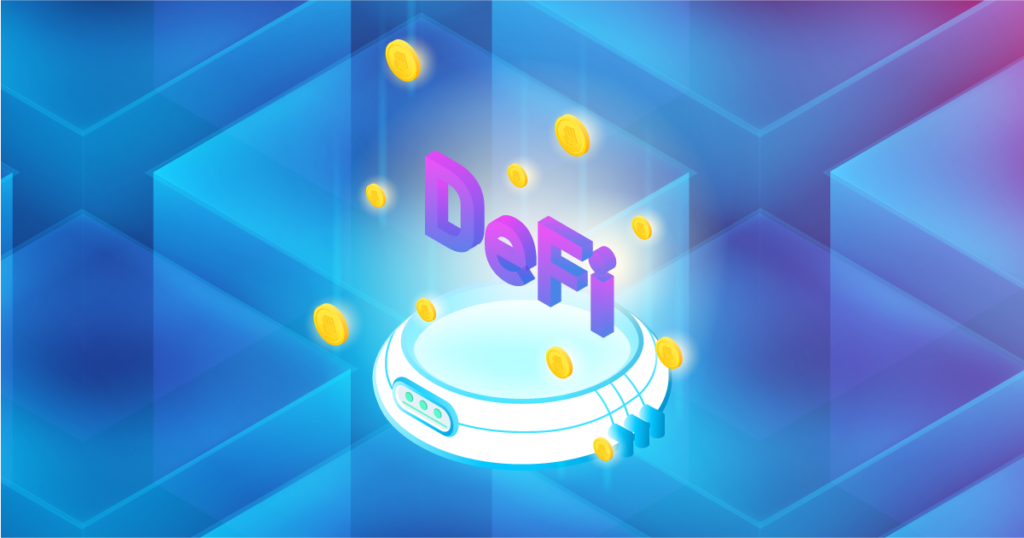What is DeFi?
The clue’s in the name: decentralized finance means taking time-proven financial mechanisms and decentralizing them through the power of blockchain technology and smart contracts.
The purpose of DeFi is to improve the efficiency and security of well-known financial concepts by removing the need to trust third parties and centralized intermediaries. Issuing stable currencies, lending money, or insuring assets — all of these things were traditionally done by centralized institutions such as banks or insurance companies, but with DeFi, they can be done automatically through a decentralized blockchain-based network powered by smart contracts.
The reason why DeFi has become so popular so quickly is the fact that decentralized solutions are not only safer and more efficient, but also more democratic. DeFi allows people to regain their financial independence and take full control over their own assets, without ever having to rely on centralized third parties like banks.
The history of DeFi

Some people say that the concept of decentralized finance is as old as cryptocurrency itself. After all, Bitcoin is undeniably a decentralized financial network. However, original blockchain projects such as BTC were relatively basic, with their sole function being to serve as digital currency.
The term DeFi was born in August 2018 with a group of developers building financial applications on the Ethereum network. It’s hard to say who specifically invented the word, as it was the result of a brainstorm between people including Brendan Forster of Dharma Labs, Blake Henderson of 0x (ZRX), and Inje Yeo of Set Protocol.
Some other names for DeFi were proposed — such as ‘Open Horizon’ and ‘Open Financial Protocols’ — but DeFi was immediately declared the best option as it was the most catchy , and it sounds like the word ‘defy’. The name apt, as DeFi solutions soon began to defy the traditional, centralized financial system.
Try P2P Swap Button
What are the use cases of DeFi?

DeFi has an almost limitless number of potential use cases. After all, everything that can be done manually by centralized institutions such as banks, investment funds and insurance companies can also be done through decentralized smart contracts.
One of the first DeFi projects on the market was MakerDAO, which used the concept of decentralized finance to issue a stablecoin called DAI. Stablecoins are cryptocurrencies pegged at a 1:1 ratio to a traditional asset, usually the US dollar. While most of the popular stablecoins like Tether (USDT) and Binance USD (BUSD) are centralized, MakerDAO uses the concept of DeFi to make a stable digital currency that is fully controlled by automated smart contracts.
Another popular use case of DeFi is ‘yield farming’, which was made popular by Yearn Finance (YFI). Yield farming is a fancy term that basically means lending your crypto assets to the network – users lock their funds in a smart contract called a ‘liquidity pool’ for a given amount of time, earning a passive income through interest.
Yearn Finance is also responsible for another influential DeFi solution called ‘yInsure’ which allows people to insure their digital assets in a decentralized and automated way. The original use of yInsure was insuring non-fungible tokens (NFTs), greatly contributing to the massive surge in the current popularity of these assets.
However, all these use cases of DeFi fade when compared to decentralized exchanges (DEXs). Decentralized exchanges have taken the cryptocurrency world by storm – the most popular DEX, Uniswap, has become a serious competitor to the industry leaders like Binance and Coinbase.
What is Uniswap?
Uniswap was launched in November 2018 and quickly became an extremely popular way to buy and sell cryptocurrency tokens – it enables people to trade Ethereum tokens (ERC-20) within a fully automated and decentralized system.
All aspects of trading on Uniswap are governed by smart contracts. Fees, transaction times, asset prices — all are established automatically by advanced algorithms.
Another important characteristic of Uniswap is that there is no central authority responsible for deciding which tokens are listed on the platform. Any developer can launch their own project on the exchange and sell tokens directly to investors, which is why Uniswap has become the chosen platform of DeFi enthusiasts.
Kirobo: the DeFi solution for making safe crypto transactions
One of the innovative DeFi solutions that has made Uniswap its home is Kirobo. Kirobo’s products are designed to solve one of the most serious problems troubling the blockchain ecosystem: the issue of risky transactions.
Research suggests that 57% of crypto users have either lost or almost lost funds because of malicious software or a simple mistake – transactions made on the blockchain are irreversible by their very nature, so a mistake when making a transaction means funds lost forever.
Kirobo solves this problem by adding extra layers of security to the process of sending crypto. For example, its undo button lets you reverse transactions and get your money back. Its logic layer, currently available on the Bitcoin and Ethereum blockchains, provides an extra confirmation stage protected by a randomized, multi-stage password, allowing users to cancel a deal if things aren’t right.
You can effortlessly buy KIRO on Uniswap by connecting your Ethereum wallet to Uniswap and paying for the purchase with ETH. After you buy KIRO, you can stake it or use it to make ultra-secure, reversible, and password-protected cryptocurrency transactions.
The article is not investment advice and must be used for informational purposes only. It is very important to do your own analysis. You can use KIRO for utility purposes only. Israeli, Canadian, and USA citizens cannot buy KIRO.